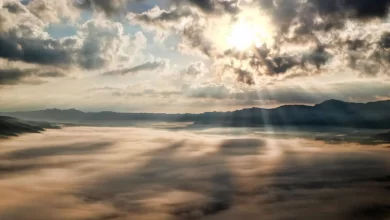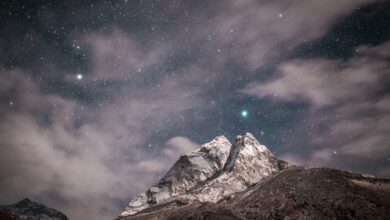Mountains are awe-inspiring natural formations that rise majestically from the Earth’s surface, often piercing the sky with their towering peaks. These geological wonders are characterized by steep slopes, rugged terrain, and breathtaking vistas. Mountains play a crucial role in shaping the planet’s landscapes and ecosystems, serving as sources of freshwater, biodiversity hotspots, and even cultural symbols in many societies. They offer opportunities for outdoor adventure, including hiking, skiing, and mountaineering, while also inspiring a sense of wonder and reverence for the beauty and grandeur of the natural world. Mountains hold a special place in the hearts of people worldwide, symbolizing both challenge and triumph, as well as the enduring power of nature.
- Mount Everest, located in the Himalayas, is the world’s tallest mountain, standing at 29,032 feet (8,849 meters) above sea level.
- Mountains are categorized as either “young” or “old.” Young mountains, like the Himalayas, are still rising due to tectonic plate activity, while old mountains, like the Appalachian Mountains, have eroded over time.
- Mountain ranges can span multiple countries and continents. The Andes in South America, for example, are the longest continental mountain range in the world.
- Above 26,247 feet (8,000 meters), climbers enter the “Death Zone” on high mountains like Everest, where the air pressure and oxygen levels are so low that survival becomes extremely challenging.
- Mountains are formed through various geological processes, including plate tectonics, volcanic activity, and erosion.
- Mountains have deep cultural and spiritual significance in many societies. They are often associated with myths, legends, and religious beliefs.
- Mountains serve as water towers for the world, as they store and release water in the form of rivers and glaciers, providing vital freshwater resources to downstream areas.
- Many mountainous regions, such as the Swiss Alps, the Rocky Mountains, and the Andes, are popular tourist destinations for activities like hiking, skiing, and mountaineering.
- Mountains are susceptible to natural disasters like avalanches, which can be triggered by various factors, including snowfall and seismic activity.
- Some of the world’s highest mountains, like K2 and Nanga Parbat, are notoriously challenging to climb due to extreme weather conditions and technical difficulties.
- Efforts are being made to protect mountain environments and biodiversity through conservation initiatives, such as establishing national parks and nature reserves.
- Mountains often have different names in different languages and cultures. For instance, Mount McKinley in North America is also known as Denali in the native Athabaskan language.
- Some mountains, like Mount St. Helens in the United States, are actually active volcanoes capable of erupting.
- Mountains are constantly changing due to erosion. Wind, water, and ice play significant roles in wearing down mountain peaks and creating unique landforms like valleys and canyons.
- Mauna Kea in Hawaii, if measured from its underwater base to its summit, is the tallest mountain in the world, surpassing even Mount Everest.
- Sir Edmund Hillary from New Zealand and Tenzing Norgay, a Sherpa from Nepal, were the first climbers to reach the summit of Mount Everest in 1953.
- Mountain regions often feature stunning alpine lakes, formed by the melting of glaciers. These lakes are known for their crystal-clear, turquoise waters.
- Some mountain ranges, like the Rockies in North America, have their own time zones. This helps accommodate the significant changes in sunrise and sunset times at different elevations.
- High-altitude mountains host specialized and hardy species of plants and animals adapted to extreme conditions, such as snow leopards and alpine edelweiss flowers.
- Some mountain roads are engineering marvels, like the Guoliang Tunnel Road in China, carved through a mountain cliff, or the Trollstigen in Norway, known for its steep and winding ascent.
- Mountains are rich sources of valuable minerals, including gold, silver, copper, and more, which have historically played a crucial role in mining and trade.
- Mountains have been a prominent subject in literature, art, and poetry, symbolizing everything from grandeur and solitude to challenges and triumphs.
- Many mountain regions around the world celebrate their unique cultures and traditions through festivals and events, often featuring music, dance, and local cuisine.
- Mountains are often associated with glaciers. These massive sheets of ice are found on many high peaks and can move slowly over time, carving out valleys and shaping the landscape.
- Due to the inherent dangers of mountain climbing, specialized mountain rescue teams are formed to assist climbers in distress and respond to emergencies.
- Several cities and towns around the world are named after nearby mountains, emphasizing the prominent role that mountains play in their landscapes and identities.
- Some of the world’s most renowned observatories are located on high mountain peaks, taking advantage of clear, thin air for stargazing.
- Mount Wycheproof is the smallest registered mountain in the world, standing 42 metres (138 feet) above the surrounding terrain and 147 metres (482 feet) above sea level in the small town of Wycheproof, Victoria, Australia.






